NDRI Links
Research
Our research activities are focused on four major areas namely the embryo biotechnologies, animal genomics, proteomics & system biology and stem cell biology. Faster multiplication of superior germplasms of dairy animals by the application of hand-made cloning technology remains one of the prime areas of our current research. Identification of superior animals utilizing the candidate genes/proteins related to economic and physiological traits of dairy animals ensuring faster genetic gains in animals and development of the selection criteria for dairy animal is the other major area. Fundamental knowledge of one gene synthesizes many proteins is being investigated at the centre to assess the economic traits of dairy animals by utilizing in vitro embryo production system followed by the molecular investigations. Exploring the reproduction traits and disease resistance qualities of Indian dairy breeds are the current interests of the research groups. Proteomics is another branch of the functional genomics, responsible for improvement of dairy production, productivity and processing areas. With the introduction of high-throughput and cutting-edge technology of mass-spectrometry for proteomic studies, the researchers at center are generating the proteomic profile of sub-clinical mastitis and matritis diseases. Early detection of pregnancy utilizing PAGs and miRNA are also being investigated at the center. Development of recombinant proteins as the intermediate technologies for fulfilling the needs of the animal and dairy industry forms another major area of research at ABTC. Many such useful recombinant proteins such as LIF, GDF-9, Lectoferrin, SSLP and amino-peptidases have been developed in the recent past. Researchers at the centre are also engaged in promoting development of designer animals and humanized dairy milk from animals by utilizing CRISPER and TALEN based genome editing tools. In the era of high usage of antibiotics in dairy industry, stem cell technology has emerged as an alternative to treatment with antibiotics for diseased udder, skin and hoof wounds. Mesenchymal stem cell technology has been developed at the centre and routinely utilized for treatment of animal diseases.
The state of art laboratories equipped with modern and high end equipments and tools are available at ABTC to carry out all research activities. The laboratories are equipped with equipments like LC-MS/MS, Flow cytometer with sorter, Bioreactors, DNA sequencer, Real-time PCR, Micromanipulator and range of incubators and freezers. A specialized bioinformatic facility is available to cater the need of researchers for studying the niche areas of bioinformatics related to animal biotechnology.












